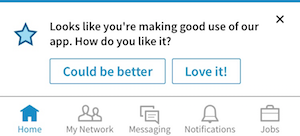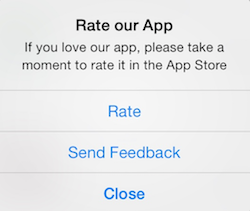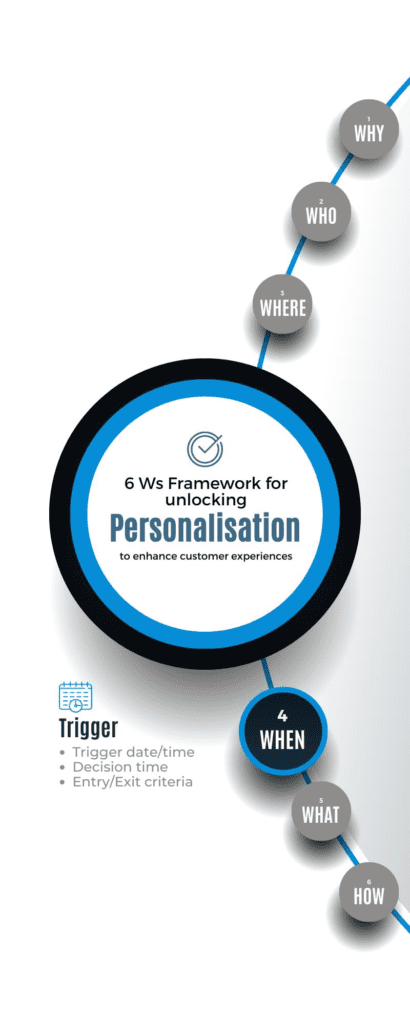A few weeks ago, while I was using the LinkedIn app for a couple of hours and engaging with articles by liking them, I received a prompt asking me to rate their mobile app.

Same day, right after installing another mobile app, I was presented with this message:

It’s not surprising which prompt I responded to, and the reason behind my choice forms the basis of this post – the timing of presenting a personalised campaign. Addressing the fourth question in the personalisation puzzle, WHEN, involves grasping the timing that renders personalisation meaningful and contextual for your audience.
A personalisation campaign manager needs to have a clear understating about when a personalised experience is delivered and equally important, when personalisation should not be done. The second experience of rating app I mentioned above not only made me think the brand doesn’t care about user-experience, but they also ended up losing a customer from providing a good review later because I clicked on Close straightaway.
Breaking WHEN Into 3 Parts:
To answer When, I break answer in 3 parts:
- Timing of experience delivery
- Timing of personalisation decision
- Entry/Exit criteria of personalisation campaign
1. Timing of Experience Delivery
In essence, it is crucial for a marketer to determine the appropriate timing for delivering personalisation. This could be as simple as refraining from sending push notifications during the early hours when they might go unnoticed or potentially annoy customers. Moreover, employing a data-driven approach can help identify the periods when the targeted audience of your campaign is most active, such as between 5pm and 7pm on a Saturday evening.
If you are uncertain about the optimal timing for your campaign, conducting a time-based A/B test can be beneficial. This test allows you to compare different sets of personalised messages at different times to evaluate which ones generate higher engagement. This approach can provide valuable insights and help you determine the most effective timing for delivering your personalised campaign messages.
Ensuring contextual campaign timing also involves carefully setting start and end dates to avoid presenting an outdated experience. For instance, it would be unfortunate to still advertise a Black Friday-only deal on the website the following Sunday simply because the campaign wasn’t turned off. By paying attention to start and end dates, you can prevent such discrepancies and provide a seamless and up-to-date experience for your audience.
Additionally, it is equally important to consider specific times when personalisation should not be displayed. Apart from the typical early morning hours or office hours, it’s crucial to evaluate the impact of personalisation on website performance. For instance, a major retailer in the US may choose to disable personalisation during peak traffic hours because it adversely affects page-load speed, which in turn negatively impacts conversion rates. By being mindful of these factors, you can optimise website performance and ensure a positive user experience during high-traffic periods.

2. Decision Timing
In addition to considering the timing of personalised experiences, addressing the When question also involves determining whether personalisation decisioning occurs during a customer’s interaction or beforehand. These two approaches can be defined as:
- Predetermined decisioning
- Real-time decisioning
2.1 Predetermined Decisioning
This type of personalisation decisioning is primarily performed using batch processes that review data about all or a specific set of customers to determine the personalised experiences that should be displayed, often in the form of offers. Predefined decisioning, although lacking in contextual information, can still be powerful, particularly for creating awareness around mass-market offers like Black Friday and other loyalty promotions.
However, predetermined decisioning may miss out on the latest customer information. For example, a customer may have already purchased the discounted t-shirt being shown as a result of an abandoned basket. Such factors can impact the effectiveness of the personalisation campaign. Despite its limitations, predefined decisioning can still serve a purpose in targeted marketing and raising awareness of specific offers among a broader audience.
Tip: If you don’t have capabilities of real-time decisioning, a way to increase effectiveness of predetermined decisioning is to reduce time between batch-processes. For instance, instead of an overnight process, explore whether batches can be generated more frequently such as hourly.
2.2 Real-time Decisioning
With real-time decisioning, personalisation decisions are made during a visitor’s interaction, allowing for the utilisation of updated context. Real-time decisioning often requires a greater investment in technology to support faster data processing. However, the returns can be higher as customers experience more relevant personalised interactions, leading to increased conversion rates.
To ensure effective real-time decisioning, it’s crucial to consider all interactions across multiple channels. Avoiding channel silos is important to gather a comprehensive understanding of the customer’s preferences and behaviour. By integrating data from various touch-points, such as website visits, social media engagement, or previous purchases, you can make informed and holistic decisions regarding personalisation. This approach enhances the customer experience and maximises the impact of real-time personalisation efforts.
3. Entry/Exit Criteria
Entry and exit criteria for a campaign are specific to that particular campaign and are established based on its objectives and desired outcomes. These criteria outline the conditions under which a customer enters or exits the campaign, ensuring that the campaign is effectively targeted and has a clear scope.
Frequency capping is a commonly used practice in personalisation where limits are set on the number of times a customer is exposed to a personalised experience. For example, ensuring that a customer doesn’t see the same personalised message repeatedly. Another example is capping the total number of push notifications that can be sent to a single customer within a week, to prevent overwhelming them with excessive notifications.
Implementing an entry criterion, such as completing a customer journey, before asking for an app rating can indeed result in better engagement. By timing the request strategically, after the customer has completed a journey or accomplished a specific milestone, you increase the likelihood of receiving meaningful feedback and enhancing the overall user experience.
Takeaway
- Ensure that campaigns are live during the time when the presented experience remains relevant to the audience.
- Understand the type of decisioning your campaign requires and assess technical feasibility beforehand.
- Define entry and exit conditions for personalised experience delivery.
In next post, I’ll share the some tips on how to craft the content for a personalised experience — answering WHAT?





